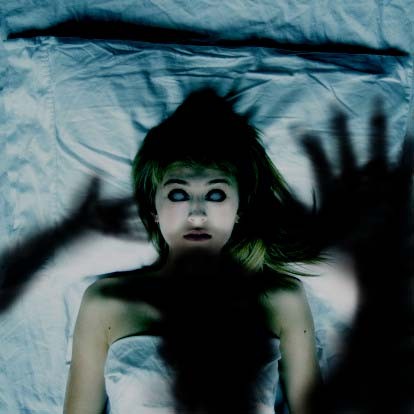Sleep paralysis is a worldwide, yet unspoken phenomenon. Director Rodney Ascher's latest documentary, "The Nightmare," sheds the light on the terrors of dreams that leak out into the reality and let the paralyzed victims experience an unimaginable fear. People insist they are real, some have learned to live with these unshakeable nightmares; others continue to live a life of depression, waiting for the answers.
Sleep paralysis means you are conscious, half awake, half asleep and completely terrified. This is, in fact, the most frightening aspect of this unexplained anomaly that the experience always leaves a negative effect on the sufferer. Although, the researchers have presented the scientific mechanism behind these real-life nightmares, but they have failed to explain why people always feel fear. The documentary featured in the Mirror might have an answer.
"The Nightmare" documentary features story of Helena Adelina, one of the millions of subjects who are suffering from nightmares, except that she gets increased episodes of sleep paralysis. Her eyes open at night, she is unable to move, but fully aware of strange entities in her bedroom. These shadow beings whisper in her ear, laugh, speak evil things and ravage her body so much so that it becomes hard to breathe.
Helena, 24, who is a film student, describes that the dark figures hover around her room. She senses them, but sometimes they not only become audible but visible as well, in the form of silhouettes. Exaggerated episodes of sleep paralysis made her so alarmed that she began to avoid sleeping and became insomniac. She is convinced that the entities are "very dark and pure evil."
Sleep paralysis is now recognized as a widespread medical condition, in which a person going sleep or waking up from it becomes paralyzed. During sleep, motor functions of the body become switched off and are turned on again as we wake up. But sometimes during this transition, the brain becomes confused whether a person is dreaming or not and decides to shut down motor functions even if the person is fully awake.
This causes strong hallucinations, blurring the boundaries between the real world and the dream world. People experience chimeras in the form of different shapes and figures. In a manner, the demons of dream escape into the waking environment and the sensations are pushed beyond reality to a degree that subjects can even feel the dream phantoms touching their bodies.
According to the documentary, reference of sleep paralysis and such nightmares is also found in the pages of history. In different cultures, it has been known by several names, but all the stories comply with symptoms shown by Helena. From ancient beings, Incubus, goblin mare, Old Hag, Night Hag, Kokma to the modern tales of alien abduction; almost all the civilizations record this happening.
Professor Chris French from the University of London is a leading psychologist and expert in sleep paralysis. He believes about 30 percent of the population have undergone the experience at least once, while 5 percent suffer increased frequency. He says that these stories are common but do not come out in open either because people are so afraid to talk about it or they do not share it because others, who have not experienced it, would think they are crazy.
If these are hallucination why people insist it is real? Professor French admits, "It doesn't have a dream-like quality; it feels incredibly real." According to him, the fear becomes an integral part of sleep paralysis, caused by unusual activity in the amygdala, a part of our brain which is the center for emotions including fear. Left with no choice, some people have embraced it as a nocturnal thrill ride, but these cases rarity.
The 2015's documentary extensively covers the sleep paralysis and gives the viewers a follow up on Helena and how she managed to improve her situation with the help of Professor French. The Nightmare can help people suffering from night visitations get a deeper understanding. On the other, IndieWire has already labeled it "One of the scariest documentaries ever."



























